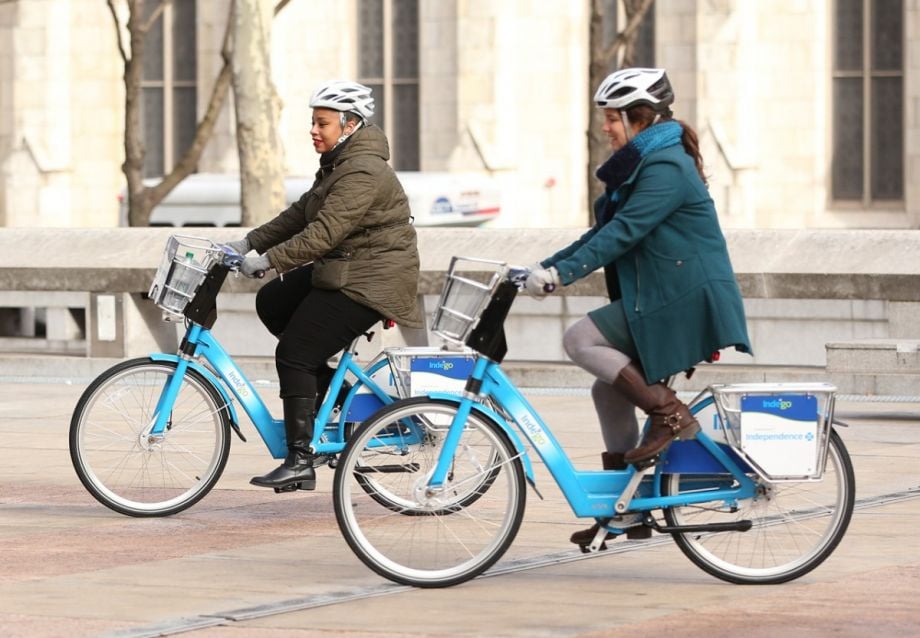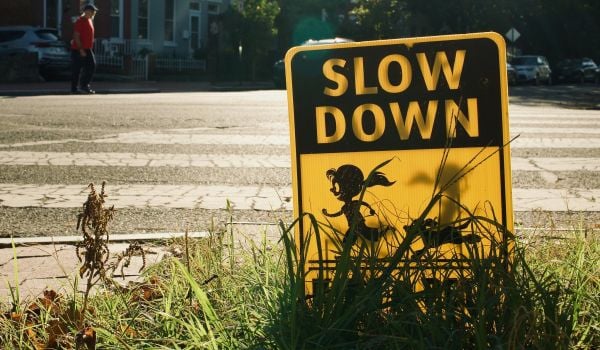When it comes to bike equity in the U.S., the focus on measuring participation rates for bike-share against population demographics misses several important points. Most critiques highlight data showing that low-income people and people of color are underrepresented in bike-share annual membership and thus conclude that funding bike-share is inequitable and inherently questionable. While the data is accurate, the conclusion is suspect. Using ridership as a measure of equity ignores the reality that bike-share programs get the highest ridership when they are in dense areas, matched with high-comfort bike lanes and connected to transit. These three factors are often missing in low-income areas and communities of color.
Compounding matters, most bike-share systems are too small to provide useful transportation options, especially for low-income people who tend to live outside of the downtown core. To date, more than 80 percent of all U.S. bike-share trips have taken place in one of four cities, New York, Washington, D.C., Miami and Chicago. The small size of most systems limits service — stations aren’t close to where people live or want to go — and further reduces ridership.
The focus on broad-brush demographics limits the funding opportunities that cities might use to improve their systems and distracts us from asking for progress on the things that bike-share, and biking in general, can do to increase equity in our highly inequitable society. During their very short history — the oldest U.S. system is less than six years old — bike-share programs are already diversifying cycling, making biking more mainstream and attractive to an increasingly wider segment of the population, and adding the weight of numbers — over 65 million trips in the U.S. since 2010 — to help push for necessary street safety improvements that can mean the difference between life and death.
To measure the success of bike-share, especially around issues of equity, we need to reset our metrics to ask what bike-share can do. Here are six things cities can do to make bike-share better and measure its impact on increasing racial and economic equity in the U.S.
Go Big and Dense
As research from NACTO and others has shown, people — of all races and at all income levels — use bike-share when it is convenient. If stations are far apart or the system is too small people won’t ride. Data from Capital Bikeshare annual members in Washington, D.C., show that people don’t sign up if stations are more than one-quarter mile (a 3- to 5-minute walk) from either their home or work.
An equitable system provides equal access to bikes throughout the program area and is big enough to provide meaningful coverage. In New York City, for example, Citi Bike stations are placed with the same high frequency in low-income areas and around NYC Housing Authority (NYCHA) campuses as in Midtown Manhattan; the system is doubling in size to cover large parts of three boroughs by 2017 and should be expanded beyond that.
Measuring success and equity by rider demographics or individual station use misses the network impact and the context. Instead, equity should be measured by access metrics like the availability of bikes (the number of bikes per 1,000 residents), the percent of low-income populations and populations of color who live or work in the service area, and the convenience and usability of the system (the number of stations per square mile with 28 stations/square mile as the ideal).
Get Pricing Right
Membership in U.S. bike-share systems can be purchased for pennies per day but equitable pricing is about more than the lump sum.
Recent NACTO research highlights the fact that monthly payment options, marketed as dollars-per-month like rent, cell phones, car payments, gyms and transit, can help reduce barriers to entry. In New York, Citi Bike recently shifted its NYCHA discounted membership from $60/year to $5/month, which better matches how people budget and spend. Offering cash-based options also matters. In Philadelphia, Indego’s cash-based membership is used by a more diverse population of riders than the credit card option. At the same time, according to Claudia Setubal, Indego access manager, when the initial cash members renewed, about 30 percent of them did so via credit card, suggesting that, beyond just addressing credit card access, having a cash option may also help remove a psychological barrier.
The presence of well-publicized monthly plans and cash memberships are good equity metrics. A focus on future innovations, like allowing bike-share access via smartphones, should also be measured.
Build a Network of Good Bike Lanes
Low-income people and people of color have a disproportionate risk of death or injury caused by bad drivers and poor road design. They are also most likely to say that introducing protected bike lanes would make them ride more. Cities around the country are just now beginning to address these disparities but there is a long way to go. While the number of protected bike lanes has quadrupled in the past five years, the overwhelming majority of streets lack safe space for people on bikes. In many cities the bike network is notional at best; most existing lanes provide insufficient protection for riders to feel safe, don’t go where people want to go, end abruptly and have limited or no connections to other lanes.
The quality and availability of a city’s bike infrastructure and its integration with bike-share can be measured by the percent of bike-share stations that are near to protected lanes, the overall network extent (lane miles), quality (protected lane miles), progress toward stated bike network goals, and through connectivity indices that measure the interconnectedness and usefulness of the city’s bike network.
Make Connections to Transit
Studies from around the U.S. routinely find that the lack of public transportation options is linked to the perpetuation of poverty. Bike-share is a natural complement for public transit. Making sure that bike-share stations are placed in close, visual proximity to transit stops can help people make first mile/last mile connections. Providing a single fare card that covers all modes is also important. LA Metro’s plans to offer a Transit Access Pass that works for bike-share and transit is a great first step.
Connectivity to transit can be measured by the number of stations adjacent to transit stops and, where jurisdictionally possible, by the provision of inter-operable memberships.
Do Real Outreach
People of color are 38 percent of the American public but for too many systems, inclusive outreach is an afterthought. The city of Philadelphia’s multi-level commitment to equitable access to bike-share offers a roadmap. In Philadelphia, Indego ads extensively feature images of women and people of color. This is a strategic choice by the city and operator to create ads that include the populations they want to reach and who often report feeling excluded from mainstream imagery and marketing. The Indego Community Ambassadors program furthers this work by hiring locals with established community roots to organize events and help promote the system. An access manager, hired by the city and embedded in the private sector operator’s offices, ensures that the equity considerations spelled out in the contract between the city and operator are truly part of day-to-day operational decisions. In New York, the outreach around station siting and ongoing partnerships with community-based organizations like Bedford-Stuyvesant Restoration, are models for active, meaningful engagement.
While outreach is notoriously hard to measure, metrics include funding, especially for full-time outreach positions, mutually beneficial partnerships with community-based organizations, and the production of inclusive advertising, in multiple languages where applicable.
Jobs, Jobs, Jobs
Bike-share programs create jobs: field and operations staff, skilled mechanics, calls center operators, marketing teams and senior management. Cities can address income and racial inequalities by integrating bike-share into workforce development programs.
In Jersey City, Motivate, the operator, recruited its launch team through a program that specializes in reintegrating formerly incarcerated people into the workforce. In Portland, 50 percent of bike-share staff hours will go to populations that the city designates as “underserved.” Citi Bike employees who started via Recycle-a-Bicycle youth training programs are now part of the management teams in Boston and New York.
Equity should be measured by the number of jobs created, the retention of employees and the demographics of people tapped for management tracks.
Encouraging people to ride bikes is fiscally sound policy that recognizes the fact that most urban trips are short and bikeable, that people walking and biking contribute more to local economies than drivers, and that building more and bigger roads will never solve our traffic congestion problems. Creating a bike transportation system requires progress in a variety of policy areas; it doesn’t stand alone. Attractive, secure bike parking stations at transit stations and bus stops, bike education in schools and for the public, repealing punitive mandatory helmet laws and riding bans that disproportionately impact low-income people and people of color, group ride programs, bike lending libraries, recycle-a-bicycle programs and bike giveaways are all part of the solution. Real, sustained commitment to building a network of protected, high-comfort bike lanes that work for cyclists of all ages and abilities, must underscore all cycling investments.
Cycling has the potential to help alter the course of generations-old inequities in transportation priorities and increase access to jobs and education. In fact, people of color are one of the fastest-growing cycling populations and most likely to bike for transportation. Cycling, with bike-share as part of it, can be a meaningful, low-cost urban travel option, but real investments must be made now for it to grow and thrive.
So let’s focus on making bike-share and cycling part of the solution to U.S. poverty, economic and environmental challenges. Let’s give bike-share, and cycling, the funding and time to help undo over 80 years of federal funding and land use decisions that enforce inequity and prioritize highways and driving at the expense of cities and communities. And let’s hold bike-share accountable to standards where we — advocates, cities, operators and planners — can change and improve.
Kate Fillin-Yeh is the director of the Bike Share Initiative at NACTO, which works with cities around the country to develop and improve their bike-share systems. NACTO is a member of the Better Bikeshare Partnership, and is grant funded by The JPB Foundation to further the conversation around equity in bike-share and help create models for replicable, equitable bike-share. Prior to joining NACTO, Kate spent six years at NYC DOT, where she was one of the chief architects of New York’s Citi Bike system.
















